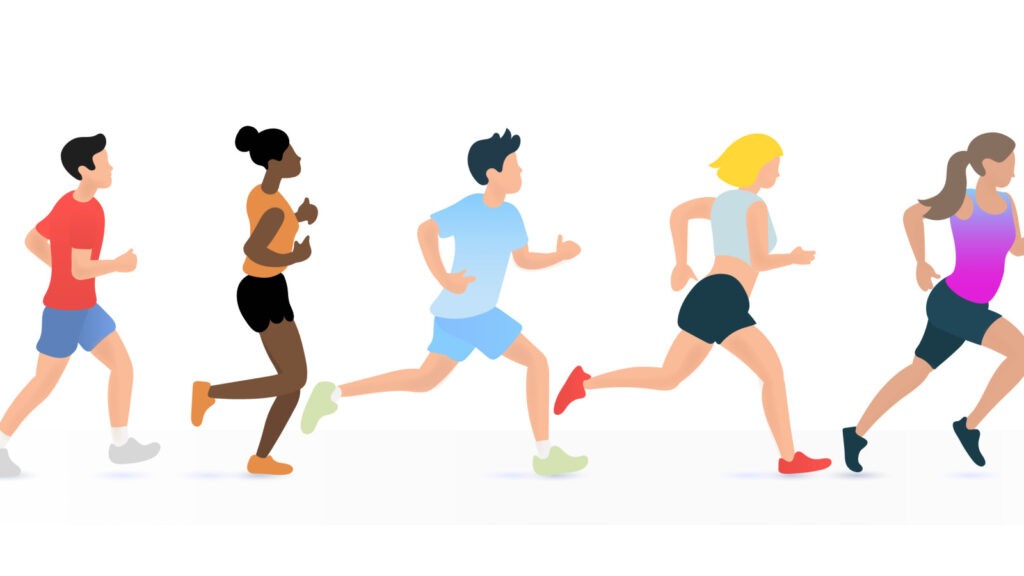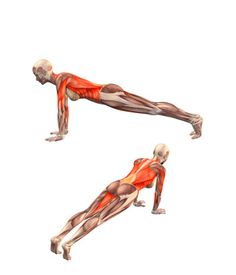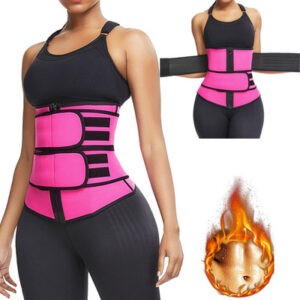A tiny waist is a dream of many; somehow, it became the sign of true femininity. Many women will do the impossible to reach this goddess-like complexion. What’s the best way to tweak your waistline? Are there any particular waist trainers workouts for quick results? What are the best exercises with a waist trainer? How to reach the goals in the shortest time possible? Read on, and we’ll answer all the questions.
Page Contents
What Is The Waist Training Workout?
The waistline isn’t only an attractive feature of your body complexion; it’s also a sign of your health. If a sick layer of fat wraps it, it may signify high blood pressure, diabetes, and excess visceral fat, the one that covers internal organs. To make sure you are on the safe side, measure your waistline.
How to do a waist measurement:
- Find the bottom of your ribs and the top of your hips.
- Place a measuring tape between them – right above the belly button.
- Don’t make it too tight, don’t ‘dig’ into your skin, aiming for lower numbers.
- Exhale naturally and take your measurement.
- Double-check the numbers.
Circumference limits:
Women | Men | |
Low risk | below 80 cm (31.5 in) | below 94 cm (37 in) |
High risk | 80-88 cm (31.5-34.6 in) | 94-102 cm (37-40) |
Very high risk | 88+ cm (34.6+ in) | 102+ cm (40+ in) |
Next step – checking your BMI – body mass index, to define your weight category. Body Mass Index is a simple calculation using a person’s height and weight.
BMI = kg/m2
A BMI of 25.0 or more is overweight, while the healthy range is 18.5 to 24.9.
If you see your numbers in a risky zone, it’s high time you change your routine and plan waist training before the situation worsens.
Sure thing after seeing the unsatisfying numbers, you’ll be willing to find the most effective quick waist training exercises and diets to help you carve a beautiful waist. If one approach doesn’t help, you’ll quickly find another one, and so on. However, it’s nothing but time-wasting. You can find exercises that target the middle line muscles, but the effect will not meet your expectations. Your waist is just a part of an issue. To reach the desirable curves, you need to exercise the whole body, tone every muscle, follow a balanced diet, lead an active life, and balance your food intake and expenditure of calories. The entire set of actions makes up a systematic approach.
Waist training workouts are a part of a regular workout routine; don’t just focus on the waistline, make the whole bodywork, and then see the long-expected results together with a more muscular torso, upper and lower part.
Waist training benefits aren’t just beauty-making; they are health-benefiting.
Is The Waist Training Workout Effective?
A waist training routine is effective if it is an integral part of a systematic approach. Every exercise and activity that you do becomes a brick that builds your health and shape. The whole body benefits from a healthy diet and exercise; moreover, you improve your mental health, reducing stress and burdensome thoughts.
How To Trim Unwanted Inches From Your Waistline?
The three pillars of an hourglass figure are – waist training workouts, change of eating habits, and sufficient sleep. However, lately, one more approach was added – waist trainer corsets, which are claimed to be helpful in forming the hourglass waistline.
The American College of Sports Medicine [1] recommends that people engage in 150–300 minutes of moderate physical activity weekly. You need to schedule your workout routine and be consistent.
Let’s discover everything you need to tweak your shape a make it as appealing as you want.
Cardio As A Waist Training Workout
Cardiovascular or cardio exercises are suitable for every person who wants to make sport an integral part of their life and can easily make the most of waist training regimen. Cardio workouts have numerous benefits:
- Intensive blood pumping.
- blood pressure regulation
- the boost of the immune system
- better sleep quality
- improved mental health
- lower blood sugar
- weight control, etc.
Besides obvious health benefits and a dream-like waist, cardio exercises are affordable and accessible for everyone: you can do them at home or the gym, inside or outside, with or without equipment.
Among all the types of aerobic (cardio) exercises, we can single out the ones you can start with:
Running
Running – the leader of cardio, which outshines all the other types. Research links running to lower stroke, cancer, and metabolic diseases like diabetes; besides, it has a proven beneficial impact on bone strength. [2]
When you are a fresh starter and have extra weight, running seems to be a challenge you can never overcome. The first runs will be short, slow, exhausting, and won’t show any results – what a disappointment! However, that’s the time you need to prove your commitment. If you fail to continue – you are not ready for profound and fundamental changes.
To stay on track, follow the following rules:
- Be realistic – don’t expect to run 5 km in the first or second week. Your whole body isn’t prepared for such stress, even if it’s highly beneficial in the long run.
- Create a training routine and stick to it.
- Be reasonable – first tuns should be a mix of running and walking.
- Incorporate running into your waist training workout. Out of 3-5 days of exercising, dedicate 2-3 to running.
- If you don’t feel comfortable practicing alone and need support, arrange with your family member or a friend – sport and quality time together will make a perfect combo.
Before lacing your running shoes, talk to your doctor to check if no health issues are preventing you from this type of sport.
While running, it’s important to get distracted – watch nature around, watch the people, listen to music or e-book – avoid fixing your mind on the time and kilometers. Otherwise, it will seem that the time is stretching, and your gadgets intentionally show a smaller distance and slower time.
Cycling
Another beneficial cardio workout that will fit any waist training workout plan. However, unlike running, it’s low-impact, causing less pressure on joints and thus, preventing injuries and strains. Cycling is:
- Relatively easy – no need for a high level of physical preparation. Most people learn to ride as kids and can never forget this skill.
- Beneficial for stamina – as any other kind of sport.
- Fun and Freedom – you’re not limited by the walls. You can vary the distances, change places, and discover new towns and cities. While enjoying your life, you get a smaller waist and improve your health – quite a good deal, isn’t it?)
- Time-efficient – if your work is relatively close to your home – up to 20-30 kilometers, you can cover this distance cycling. And again, two benefits in one fell swoop – no traffic jams, lower waist – what else can make you even more motivated?
Planking
The plank exercise is a fitness classic that never dies. Its variations will make perfect waist training exercises at home. It provides countless benefits for increasing activity in your core and abdominal muscles. It helps you build the strength of back muscles, allowing you to stand upright and support your spine during everyday movements. The variations of planks target different muscle groups, including the waistline. These are two basic exercises suitable for waist training for beginners.
Forearm Planking
How to do:
- Start in a table-top position on the floor with hands directly under shoulders; knees are bent.
- Your feet are hip-width apart. Lower one forearm down to the floor; elbows align with shoulders.
- Place palms firmly on the floor.
- Lift both knees off the floor, straighten legs to come into a forearm plank position; squeeze the glutes together and engage the core.
- Push away from the floor and maintain a straight line from head to heels.
Aim for 45 seconds, in the beginning, gradually extending the time, and listen to your body. Start with 3 sets.
High Plank
How to do:
- Start in a table-top position on the floor with hands directly under shoulders, knees bent, and feet hip-width apart.
- Lift both knees off the floor, straighten legs to come into a high plank position on palms; squeeze the glutes together, and engage the core.
- Push away from the floor and maintain a straight line from head to heels.
Aim for 45 seconds, in the beginning, gradually extending the time. Start with 3 sets.
Waist training corsets
A waist trainer is a waist-shaping tool. The users who wear a waist trainer for a month or two in a row claim that it ‘teaches’ your waist muscles to keep the proper form, keeping the midsection as tight as possible.
Waist trainers are made of tough fabric and hard fibers. As long as there is no profound research base, it’s hard to ensure the waist trainer benefits. However, the assumptions are the following:
- Tiny waist
The primary positive influence the waist trainer may make is a quick and tiny waist. The person is supposed to wear it during the day – a type of waist training regimen – and the muscles are set right into the required position. This result is accurate, and you can happily notice the changes in your body shape and waistline. However, this happiness won’t last long. A few days, not more [3].
- Weight loss
Any effect of waist trainer may have a minor influence on the body weight, as long as it causes constant sweating, thus losing water weight. Besides, while wearing the corsets, the person may feel a reduced appetite due to the tightness around the stomach.
Some people even wear a waist trainer during exercise to create a thermal activity, which can be pretty dangerous, as long as it limits breathing capacity and movement.
- Better posture
Wearing a waist trainer for better posture will have doubtful benefits. The straight posture is provided by the strength of the back muscles, which is obtained by a regular fitness routine. The first day of wearing the corset may possibly improve the posture; however, in the long run, it will just weaken the core muscles.
Risks of wearing waist trainers:
The list of risks is significantly longer than the doubtful benefits.
- Breathing problems – wearing a waist trainer while exercising can cause a shortage of breath and a reduction of lung capacity by 30-60%.
- Internal damage – the midsection, being constantly squeezed, may cause dysfunction, as all the organs are tightly pressed again each other. A blog post from the Royal College of Surgeons of England [4] mentions that long-term use of a corset may lead to the deformation of the rib cage.
- Digestive issues – The stomach may not digest the food properly due to a constantly pressed state.
Best waist training results can come from your diligence and perseverance, not from a piece of fabric.
Is waist training safe?
Wearing waist corsets for best results in weight loss and forming the waist shape is just another passing fad. Initially, it may have kind of a thinning effect, but it can’t be a long-term solution to provide you with health benefits.
While it’s not the best option to wear the corsets all day long, they may be especially harmful if worn while at the gym. If a person feels lightheaded or short of breath, it’s time to get rid of a waist trainer and move on to a normal fitness regimen.
Stick To A Healthy Diet
A healthy diet is a great key to better health and well-being; it provides you with all the nutrients and vitamins essential for your body’s proper functioning. Looking for the best diet to slim your waist is losing time. There’s no best diet for an hourglass waistline like there are no best waist training exercises. However, there’s natural and healthy food that must be included in your dietary regimen.
If you want to lose weight, opt for 1-2 pounds a week, which is 500-1000 calories down a day. If you start eating healthy and nutritious food when you feel a physical need and exercise regularly, you will see great results in your work quite soon. And what’s more important, you will not exhaust your body with a meaningless diet and tight corsets.
Sleeping routine
Quality sleep is essential for your health and healthy weight loss. When you’re asleep, your body has time to repair itself. If your sleep length is 7-8 hours a day, you’ll feel refreshed in the morning and ready for a new day.
However, if you decide to exercise 1-2 hours before going to bed, you may experience sleepless nights – exercising provokes the release of endorphins, which relieve the level of stress and activate your brain instead of letting it rest.
The Ultimate Rules To Stick To
- Commit to a regular schedule – set a goal of weekly 2-3 waist training workouts. Don’t track the time and intensity yet; let your body adjust. Just by following the waist training regularly, you will reach the first results.
- Focus on your form and technique – firstly, learn the technique, then think about the intensity. Otherwise, you may have injuries.
- Change your diet – proteins, complex carbs, and healthy fats make the basis of your dietary regimen and refill your needs in essential macro- and micronutrients.
If you follow these basic rules, you will be well to achieving the slim waistline you have always wanted.
Conclusion
People show all the spectrum of impatience and hunger for quick changes when it comes down to losing weight. That’s why they quickly buy the idea of slimming pills, or waist trainers, believing in a ‘less effort – more result’ approach. However, it will never work like that in terms of sports and weight changes.
Such tools will give you vain hope and discouragement, taking your time for useless things.
Instead of finding the easiest and quickest way to lose weight, make it a pleasant journey toward bettering yourself. Change your lifestyle, add more movement to your life, and discover the world around you. Let your body be strong; give it a sufficient amount of exercise. Change what you eat and why you eat it – food gives you the energy to live; it’s not a unique source of happiness.











